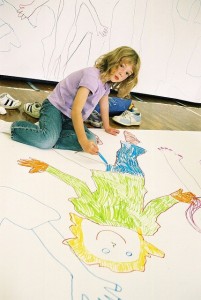I drove to Vancouver and back this weekend. As I was by myself, I had lots of time to think, which, these days, is a luxury. Being a mom to two teenage sons and a teacher who is at the end of the school year means that I have a very full schedule at the moment. Even though I’m committed to self-care, quiet time to reflect and let my mind wander is rare. I enjoyed the drive because of the beautiful sunshine, gorgeous scenery and the realizations that came with the time to think. One of those realizations was the evolution of my research interests. Here is a list of my musings in no particular order as these topics constantly jostle and re-rank themselves day to day.
Research Interest #1: Visual Literacy and Arts-Based Methods
I had a lovely day Saturday with the BC Art Teachers’ Association (BCATA) Executive. It was the last meeting of the school year and many of us went out for lunch afterwards. I’ve been a district rep for the BCATA for over ten years but only joined the executive as the intermediate rep last year. What an amazing group of people. So inspiring. I feel as if I’ve found my tribe. I want to help them advocate for the arts and love sitting at that table.
I realized, when driving home Saturday, that being a part of the BCATA Executive feeds my interest in the Visual Arts, and, in particular, my passion for visual literacy and arts-based methods. This strand of my MEd research is still super important to me and I wasn’t aware, until Saturday, that I was carrying on with learning about this strand of research in this way. I think it’s pretty neat that I found my way to such a cool group of people that can gently push me along in my continued learning about Arts Education.
Research Interest #2: (Digital) Citizenship
When I was starting to jot down the notes for this blog post, the continuation of my learning with this topic was the one that is the most obvious. Unlike the other two interests that somehow snuck up on me in a formal-research-kind-of-way, I know that I’m always immersed in learning more about digital technologies. I don’t see how a person can teach kids today and not be. It’s such a huge part of the world and a huge part of kids’ day to day lives. Being a part of the Elementary Connected Classrooms project allows me the opportunity to integrate technology into my teaching practice and student learning on a daily basis. I love that I can always learn more about technology and constantly feed my curiosity to check out the latest platform, explore a new tech tool or read the latest updates on anything and everything tech. This strand of research always seems present in my life.
Research Interest #3: Métis and Cree Epistemologies
This one’s a big one right now. Well, it’s always a big one, as it flows through my veins and shapes every thought, interaction and behavior each day, but it subtly took over last year and is quietly and persistently refusing to be ignored.
You see, when I was off on a medical leave last year, I quickly became very, very bored. Netflix was great for awhile, but I lost interest sooner than I’d expected. And, disappointingly, I could only read so many books. What I needed was intellectual stimulation. So. I started to write.
I’ve always enjoyed writing. I attended a Young Author’s contest when I was 12 and have always wanted to be a writer. So, because I was bored and had the time, I started to write. I also began to dive in to the whole world of being a writer. I joined writer’s groups online, bought a few highly recommended books on writing and even attempted NaNoWriMo (I failed. Miserably. A story for another day…).
I have a good, and I think, unique question that is driving my story. One Saturday night in March, sitting on the floor of my study, surrounded by all of the articles I’d read when working on this strand of research for my MEd in 2011, I realized I had slipped right back into researching again. Somewhere along the line, I started diving deeper and deeper into the Métis and Cree storyline (now and in the past 300 years or so) as that plotline crept it’s way into farther into my book. Through writing I had slipped back into my MEd research, which immediately made me think…hmm…I wonder if I can write a novel as part of a PhD? (A question I’ve since had answered. Again, a story for another day…). And so, through writing as inquiry, in a way, I continue to learn more and further my research on Métis and Cree epistemologies. And I’m over 14 000 words for my book too!
It was a powerful realization that I feel the need to continue to follow these research interests in some way. I’m compelled to do so. I can’t be me without learning more about my Métis and Cree heritage. I’m not truly happy if Visual Arts isn’t some sort of priority in my life. I don’t feel right if I’m not immersed in learning the latest about educational technology and the effect this has on children and youth growing up today. I’d had no idea what a transformative experience the Masters coursework would have on me. Thanks again to Vicki, Lynn and Leyton – the MEd experience doesn’t seem to have an end point. I like that it’s become so fully and completely integrated into my personal and professional learning in general.

